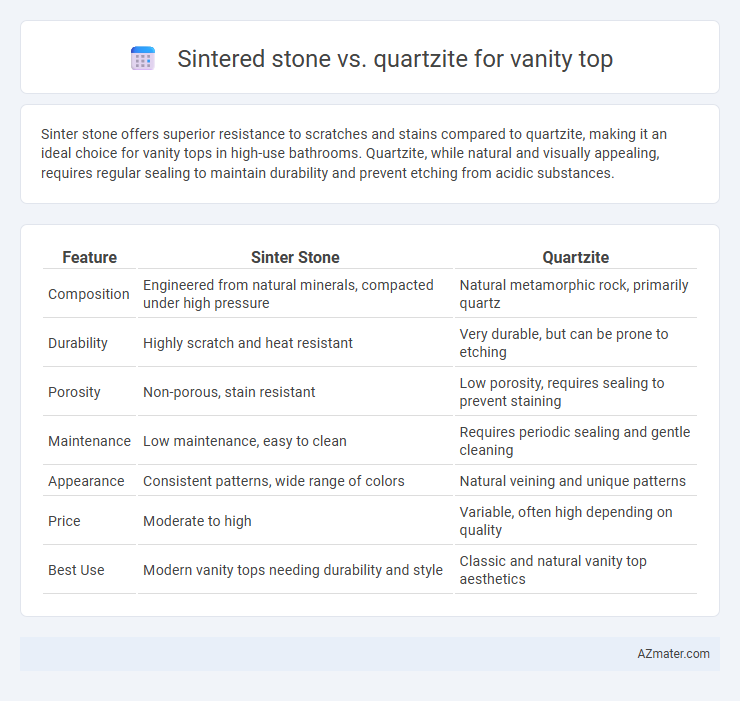Sinter stone offers superior resistance to scratches and stains compared to quartzite, making it an ideal choice for vanity tops in high-use bathrooms. Quartzite, while natural and visually appealing, requires regular sealing to maintain durability and prevent etching from acidic substances.
Table of Comparison
| Feature | Sinter Stone | Quartzite |
|---|---|---|
| Composition | Engineered from natural minerals, compacted under high pressure | Natural metamorphic rock, primarily quartz |
| Durability | Highly scratch and heat resistant | Very durable, but can be prone to etching |
| Porosity | Non-porous, stain resistant | Low porosity, requires sealing to prevent staining |
| Maintenance | Low maintenance, easy to clean | Requires periodic sealing and gentle cleaning |
| Appearance | Consistent patterns, wide range of colors | Natural veining and unique patterns |
| Price | Moderate to high | Variable, often high depending on quality |
| Best Use | Modern vanity tops needing durability and style | Classic and natural vanity top aesthetics |
Introduction: Sinter Stone vs Quartzite Vanity Tops
Sinter stone and quartzite are both popular materials for vanity tops, known for their durability and aesthetic appeal. Sinter stone offers superior resistance to scratches, stains, and heat due to its engineered composition, making it ideal for high-traffic bathrooms. Quartzite, a natural metamorphic rock, provides unique veining and natural beauty but requires regular sealing to maintain its resistance against moisture and acids.
Material Composition and Formation
Sinter stone, made from finely ground natural stone fused through high heat and pressure, offers non-porous, durable surfaces ideal for vanity tops. Quartzite, a natural metamorphic rock formed from sandstone under extreme heat and pressure, features high quartz content that provides exceptional hardness and resistance. Both materials exhibit superior durability, but sinter stone's engineered composition allows for consistent patterns and enhanced stain resistance compared to natural quartzite.
Aesthetic Appeal and Design Options
Sinter stone offers a sleek, uniform appearance with contemporary edges and a wide range of colors, making it ideal for minimalist and modern vanity tops. Quartzite provides natural veining and unique patterns that enhance the aesthetic appeal of luxury and traditional bathroom designs. Both materials support various design options, but quartzite's organic texture offers a more distinct, natural look compared to sinter stone's consistent finish.
Durability and Strength Comparison
Sinter stone offers exceptional durability with high resistance to scratches, heat, and stains due to its engineered composition and advanced manufacturing process. Quartzite, a natural metamorphic rock, boasts impressive hardness and strength, making it highly resistant to wear and impact but may require periodic sealing to prevent staining. Both materials provide robust options for vanity tops, though sinter stone often excels in uniformity and low maintenance compared to quartzite's natural beauty and strength.
Water and Stain Resistance
Sinter stone offers exceptional water and stain resistance due to its non-porous, engineered surface, making it ideal for vanity tops exposed to moisture and cosmetics. Quartzite, while naturally durable and resistant to heat and scratches, requires regular sealing to maintain its water and stain resistance properties. Choosing sinter stone can reduce maintenance and enhance longevity in bathroom environments with frequent water exposure.
Heat and Scratch Resistance
Sintered stone offers exceptional heat resistance, withstanding temperatures up to 1,200degF without damage, making it ideal for vanity tops exposed to hot styling tools. Quartzite is a natural stone that also provides strong heat resistance, though it can be more prone to thermal shock if subjected to sudden temperature changes. Both materials exhibit high scratch resistance, but sintered stone generally ranks higher due to its engineered surface, reducing the risk of abrasions in daily bathroom use.
Maintenance and Cleaning Requirements
Sintered stone offers exceptional resistance to stains, scratches, and heat, requiring minimal maintenance with only regular wiping using mild soap and water for cleaning. Quartzite, while durable, demands more care to prevent etching and staining, necessitating periodic sealing and gentle cleaning with pH-neutral products. Choosing sintered stone for vanity tops ensures easier upkeep and long-lasting aesthetic appeal with less stringent maintenance routines compared to quartzite.
Cost and Value Analysis
Sinter stone offers a cost-effective solution for vanity tops, with prices typically ranging from $50 to $150 per square foot, making it more affordable than quartzite, which averages between $70 and $200 per square foot. Quartzite provides exceptional durability and natural stone aesthetics, adding higher resale value to bathrooms compared to the engineered composition and consistent appearance of sinter stone. Considering long-term value, quartzite's superior scratch and heat resistance justify its premium cost, while sinter stone appeals to budget-conscious projects needing versatile and low-maintenance surfaces.
Environmental Impact and Sustainability
Sinter stone is engineered from natural minerals and recycled materials through an eco-friendly, low-energy sintering process, resulting in a highly sustainable vanity top option with minimal environmental impact. Quartzite, a natural metamorphic stone, is quarried from the earth, leading to higher energy consumption and habitat disruption in extraction and transportation. Choosing sinter stone supports resource efficiency and reduces carbon footprint compared to traditional quartzite slabs, making it a greener choice for eco-conscious bathroom designs.
Which is Best: Sinter Stone or Quartzite for Vanity Tops?
Sinter stone offers superior durability and non-porous properties, making it highly resistant to stains, scratches, and heat, ideal for vanity tops exposed to moisture and daily use. Quartzite, a natural stone, provides exceptional hardness and a natural aesthetic but requires regular sealing to prevent stains and etching. For low-maintenance, long-lasting vanity surfaces, sinter stone generally outperforms quartzite in both performance and ease of care.

Infographic: Sinter stone vs Quartzite for Vanity top
 azmater.com
azmater.com